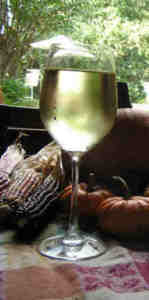
|
Riesling Revival This vastly underappreciated noble grape is finally emerging from the Chardonnay shadow.
By: Thomas M. Ciesla |
|
| |
|
Liebfraumilch |
Back in the 1970s when my refrigerator usually held wines with names like Blue Nun, Piesporter and Liebfraumilch. Sweet and cheap these wines were approachable to the immature palate and served as an entry point into the world of wine. In a sense, these wines were the precursor of todays 'white zinfandel'. Sadly, the stigma of sweet and cheap has lingered for decades regarding these brands: when you say 'German wine' to most folks, it's these three wines that pop into mind. Though the Riesling grape is sometimes used in the production of these wines (more often it's Syrvaner), this category of wine has little to do with a true Riesling.
The Riesling (pronounced reeez-ling) grape, also known as Johannisberg Riesling, White Riesling, Weisser Riesling, Rheinriesling and Riesling Renano, has been grown in Germany's Rhine and Mosel Valleys since the 14th century. It is the most planted grape in the Rhine Valley: people who talk about a 'Rhine Wine' are talking about a Riesling. It has also been the dominant grape in the Alsace region of France, and these two countries have come to define how a Riesling should be grown and produced. Known as the noblest of the noble grapes, Riesling wines were also popular in England over the centuries; so popular in fact, that the wine found its way into literature. In Hamlet, the wine that the Danish court gets drunk on is a 'Rhine Wine." |
|
|
TERROIR! One distinguishing fact about the Riesling grape is that it can produce wines across the entire spectrum of style, from a dusty dry, almost flinty, to a magnificent sweet nectar. This Riesling chain is a celebration of a winemakers vision and restraint. Rieslings superiority over other grapes stems from its late ripening cycle, allowing it the time to extract the minerals and trace elements in the soil, giving full expression to the terroir. Everything the vine has experienced in the vineyard can be sensed in a single glass of wine. While it is true that other wines can express terroir with uncanny precision, their character is often altered by oak treatment. This isn't the case with Riesling, where new oak plays no part in its production, though European winemakers sometimes will use older, neutral oak in 1,000 liter oval casks to finish the wine. The typical low alcohol levels of riesling also helps to allow the nuances of the vineyard to be expressed. |
|
German Terms For
|
STYLES OF RIESLING Riesling is usually produced in three distinct styles: dry, half dry, and sweet. Picking the grapes early when the sugar content is low results in a crisp, fruity aromatic wine that is low in alcohol. If you wait a bit longer to harvest, the sugar levels rise slightly and you produce a semi-dry Riesling. If the harvest is done late in the season when the berries have fully ripened, the sugar content is high, resulting in the classic 'sweet' Riesling with complex bouquets. During the 20th century ,planting of Riesling grapes spread from the Old World to wine regions in the northern and southern hemispheres. However, with few exceptions the wines produced lack the unique character expressed by the conditions in the Mosel and Rhine Valleys. There the cooler climate allows the grape to ripen over an extended growing period and the predominantly slate soils impart a mineral component to the wine. Still, a number of North American and Australian producers are committed to creating high-quality Riesling.
|
|
Texas Riesling Producers
|
NEW WORLD RIESLINGS
In the United States, Riesling is seeing a renaissance in New York State's Finger Lakes Region, Michigan, California, Washington, and Oregon. The cooler climate and slate soils of the Finger Lakes Region come close to the conditions in Germany, but Washington State is the largest producer of Riesling at this time, thanks to one winery — Chateau Ste. Michelle — currently bottling 200,000 cases of Riesling annually. California is home to a number of Riesling producers, but experts feel that the wine will never be a predominant component of the California wine market, a market dominated by Chardonnay and other trendy white wines. In Texas, like California, the generous amounts of sunshine ripen the grapes quickly, resulting in a Riesling that is more gentle and less intense. The short time on the vine prevents the grape from doing what it does best — absorb the character of the vineyard. In the Lone Star State, production of Riesling grapes has remained relatively the same for years at roughly 120 acres. One winery, Messina Hof Winery & Resort dominates the market, using roughly 85% of the crop produced in the state. The winery produces three Rieslings: a dry at 0% residual sugar, a semi-dry at 1% residual sugar and a late harvest at 8% residual sugar. According to Amber Bagwell, Director of Public Relations and Marketing for the winery, "Our 1% residual sugar outsells the 0% residual 10 -to -1." Several other Texas wineries include Riesling in the wine portfolio, usually offering both a semi-dry and sweet version. However, just as with California, Riesling is not expected to be a major component of the Texas wine industry. Surprisingly, Australia is now at the forefront of the Riesling Revival, being known worldwide for the purity of its Rieslings. These bold and aggressive 'down-under' producers are setting the New World standard for the best dry versions of the varietal. Their wines offer unique regional characteristics and their aggressive marketing efforts are sure to elevate Riesling awareness in the United States. The Clare Valley in South Australia is the source for most of Australia's best Riesling, with two enclaves, Watervale and Polish Hill River being especially renowned. |